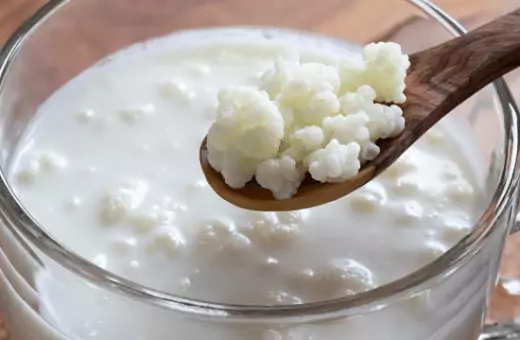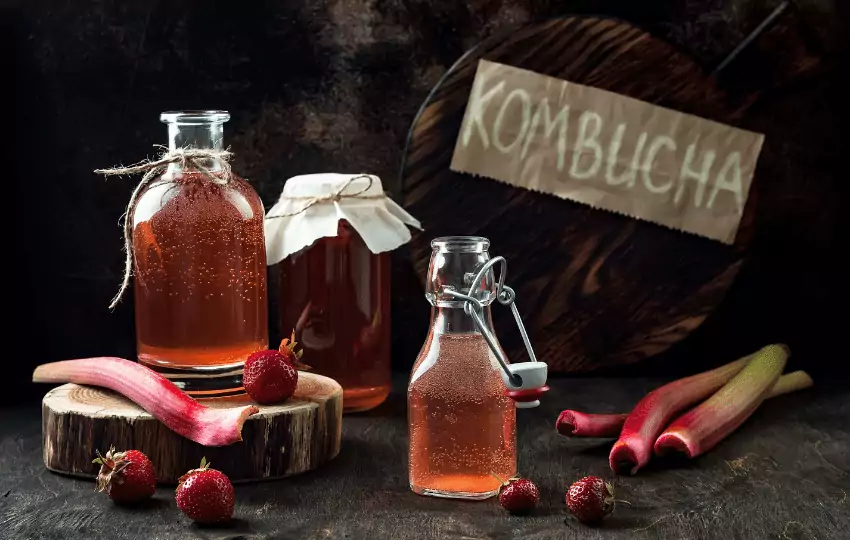If you are looking for a way to add probiotics to your food without kombucha, then look no further. We have the perfect solution!
You can use our best substitute for kombucha in various dishes. It will enhance the flavor and give similar benefits to your dish. It is a suitable way to add flavor without making an extra trip out or spending time looking.
What is Kombucha?
Kombucha (pronounced kom-BOO-shuh) is an effervescent fermented drink made of tea, sugar, and a SCOBY (a symbiotic colony of bacteria and yeast).
The kombucha practices described here can be used to make kombucha tea at home.
Kombucha is produced worldwide. It’s typically made in homes, restaurants, and cafes by fermenting different types of tea.
Kombucha has been in existence for thousands of years. Still, in the United States, it’s gained popularity in recent years because of its taste and purported health benefits.
To make kombucha, a SCOBY is used to ferment sweetened tea for about a week. The resulting beverage is a slightly acidic drink containing various B vitamins and other organic acids.
It’s also naturally carbonated, similar to soda, though much less carbonated than commercial soft drinks.
· Other Names of Kombucha- tea mushroom, tea fungus, and Manchurian mushroom.
7 Most suitable Substitutes for Kombucha
Multiple probiotics are found in the various fermented drinks available to us; incorporating a variety of drinks in your diet can assist you in absorbing the multiple strains. Here are a few probiotic beverage alternatives to kombucha.
1.JUN- Similar to Kombucha
Jun, also known as Xun, is made from green tea and honey, similar to kombucha and a great substitute for kombucha.
You can get Jun either simple Honey green tea flavor or sometimes available in different forms like herbs, spices, etc.
Jun ferments in 5–7 days, which is substantially faster than most other fermented beverages.
Although brewing jun takes only one process, it is sometimes done in two steps. The added operation can add taste and carbonation, making the beverage more appealing.
A jar (glass or porcelain is usually used), a SCOBY (symbiotic culture of bacteria and yeast), honey, green tea, and filtered water are all needed to make Jun. The exact ratios will vary based on the recipe and individual choice.
2. GINGER ALE- Easy Non-Alcoholic Substitute for Kombucha
Ginger ale is another probiotic beverage made of ginger, water, yeast, and sugar. It is simple to find at any store and can also be manufactured at home.

It is often used to treat motion sickness and indigestion, also substituting Champagne vinegar.
3. KVASS – Best Low Alcoholic Alternative to Kombucha
Kvass is another fermented drink that good kombucha substitute made from Rye bread and popular in European countries.
If you want low alcohol content or a non-alcoholic replacement for kombucha, Kvass will be a great option.
It has a dark brown cloudly appearance with a sweet and sour aftertaste. The most amazing fact about kvass is that it comes with different flavors, including honey, fruity cherry tone, and herbs in barry flavor.
4. TIBICOS – Water Kafir A Decent Replacement for Kombucha
Water kafir known as tibicos is a homemade probiotic beverage that often substitutes kombucha and other dairy-based probiotic drinks.
Water kafir is mainly a Mexican drink with a similar flavor and culture like kombucha, yeast, and Scoby also used here. Also Sweeter than Kombucha.
Tibicos are introduced to a sweet beverage and processed for 24 to 48 hours in the most simple production process. Instead of tea, it’s made with sweetened water, coconut water, or other natural fruit liquids.
5. Substitute REJUVELAC for Kombucha
Rejuvelac is made for sprouted buckwheat and soaking for at least two days at room temperature in normal water. Then start for the second series and preserve the fermented liquid.
The grain/pseudocereal can be used to make a second batch, which will ferment in about one day. It’s feasible to make a third batch, although the flavor can be unpleasant. After that, the leftover grain/pseudocereal is normally removed.
6. KEFIR – A Dairy-Based Kombucha Substitute
Kefir is a fermented milk-based drink popular in Russia Eastern European countries.
Kefir is traditionally fermented at room temperature, usually overnight. Lactose fermentation produces a sour, fizzy, moderately alcoholic liquid with the appearance and flavor of liquid yogurt.

You can have it in a milkshake, salad, cereals, dressings, mixed with soup, and ice cream in sourdough and best buttermilk substitute for baking.
7. Try TEPACHE instead of Kombucha
Tepache is a popular Mexican refreshing drink with little alcohol made from pineapple juice. It is made from the fruit peel and flesh that is sweetened with piloncillo or brown sugar, flavored with crushed cinnamon, and served chilled.
Even though tepache is brewed for many days, the resultant drink contains very little alcohol.
Read More- Healthy SPAM Substitutes
What do you need to make kombucha?
To make kombucha, you need the following:
– a SCOBY (a symbiotic culture of bacteria and yeast – or to give it its proper name, a “symbiotic colony of bacteria and yeast” or just “starter”)
– Tea (any kind of black tea or even green tea will do)
– sugar (white, brown, raw – doesn’t matter, though avoid fructose)
– water (again, any kind of drinking water will do)
You also need a few jars or other vessels to brew the kombucha.
You don’t need to buy anything specialized for this; just use any old jars you can find – jam jars are ideal. If you don’t have any jars, plastic buckets from DIY stores work well too.
Avoid metal containers, though – the kombucha reacts with metal.
You can flavor your kombucha with any kind of fruit juice. Fruit juices work well for flavoring because they contain acids that help cut through kombucha’s sourness – but remember that they will also increase the sugar content.
How to make homemade kombucha fizzy
There is nothing like the fizz of a good Kombucha! But when you make your own, it’s easy to find yourself with flat Kombucha.
Kombucha is a fermented beverage created with black tea, sugar, and microbes. The bacteria cause the drink to become carbonated and fizzy. To make kombucha fizzy, you need to add some yeast.
You can get yeast from a store-bought kombucha or make your own yeast starter.
To make your own yeast starter, you will need:
-1 cup of warm water
-1/4 teaspoon of sugar
-1/4 teaspoon of dried yeast
Mix the sugar and yeast together in the warm water and let it sit for about 10 minutes. Add the yeast to your kombucha mixture once it has activated.
If you don’t like the taste of kombucha, or if you want to make it sweeter, you can also add fruit juice to the mixture. Just make sure you add more sugar to counteract the fruit juice and keep your kombucha at a similar level of sweetness.
Kombucha as a wine substitute
Kombucha is a fermented black tea and sugar beverage. It is often consumed for its purported health benefits.
Kombucha has been used as a wine substitute by people looking for an alcoholic drink that is healthier than wine.
Kombucha contains less sugar and fewer calories than wine. It also contains probiotics, which are beneficial bacteria that promote gut health.
Kombucha substitute for alcohol
Although kombucha is often consumed as a substitute for alcohol, it does not have the same effects.
Kombucha contains trace amounts of alcohol, but it is not enough to get you drunk. Additionally, kombucha contains high levels of acids and bacteria, which can be harmful if consumed in large quantities.
If you’re searching for a drink that will bring the same buzz as alcohol, kombucha is not the right choice.
Can you make kombucha with less sugar?
If you enjoy your kombucha to be less sugary, consider using green tea instead of black tea. It’s not as tasty, but it has a fraction of the sugar of regular tea.
Can I make kombucha without sugar?
As you might know, kombucha is made by fermenting tea with sugar and a symbiotic culture of bacteria and yeast (SCOBY). It is essentially a form of vinegar.
Some people raise their blood sugar levels by drinking kombucha, despite containing trace amounts of sugar.
So One Big Yes. You can make Kombucha without sugar. Below are 6 possible options to make kombucha without sugar.
A sugar substitute for kombucha
1) Use a Sugar-Free Tea
Several teas available have no added sugar, so always read the label.
For example, some rooibos teas contain no sugar and are naturally sweet. Other examples of tea that contains no sugar include:
- Green tea
- White tea
- Black tea (only if it’s not blended with any other type of tea that has sugar)
- Oolong tea
- Herbal teas such as chamomile, peppermint, etc. (However, certain herbal teas may not ferment properly)
2) Add Stevia
Stevia, also known as “sweet leaf,” is a natural plant that is 200-300 times sweeter than sugar.
Stevia is an excellent choice for people trying to avoid sugar because it has little impact on blood sugar levels. It also does not feed candida, which can help prevent yeast overgrowth.
However, use stevia in your kombucha. You should only use the pure form of stevia, not any type of “stevia blend” (e.g., stevia + erythritol blend).
3) Use Monk Fruit
Monk fruit has become a popular sugar substitute because it is 200-300 times sweeter than sugar. Still, it does not have the same after taste as stevia.
Monk fruit is also considered safe for diabetics because it does not raise blood sugar levels.
Monk fruit is typically sold as a concentrate. You can mix with water or other liquids to sweeten them naturally. You can also buy monk fruit in pure form, but it is not as easy to find.
4) Make a Sweet kombucha Tea With Fruit Juice
Many fruits naturally contain sugar that you can use to make kombucha without sugar.
For example, if you add one part fruit juice to two parts freshly brewed tea, you have a sweet kombucha.
Having said that, this strategy is not perfect for persons who want to minimize their sugar intake.
For example, juice contains a lot of fructose (fruit sugar) which can raise blood sugar levels in people who are insulin resistant or diabetic.
One option is to make kombucha with a mixture of 50% fruit juice and 50% tea. This way, you can enjoy a sweet kombucha without causing any negative health effects from drinking too much sugar.
5) Use 100% Fruit Juice
Using 100% fruit juice to make kombucha is another option. Remember that you are adding a lot more sugar, so this method is not ideal for people with blood sugar regulation issues.
If you use 100% fruit juice, try to find 100% unsweetened juice because many fruit juices have added sugar.
One option is to use a premade kombucha that is flavored with 100% fruit juice instead of added sugar sweeteners.
You can also brew kombucha with 100% fruit juice, for example, apple juice.
However, you should make sure you do not add too much juice because it will increase the sugar content of your kombucha.
The problem is that 100% fruit juice does not contain the “tea fungus culture,” – so you want to limit the amount you use.
Here are the sugar contents of some of the most popular fruit juices:
· Apple juice – 19 grams of sugar per 8 ounces glass (41%)
· Orange juice – 16 grams of sugar per 8 ounces glass (33%)
· Grapefruit juice – 12 grams of sugar per 8 ounces glass (25%)
· Cranberry juice – 26 grams of sugar per 8 ounces glass (53%)
6) Make a Sweet Tea With Coconut Sugar
Coconut sugar is gaining popularity because it contains minerals, antioxidants, and vitamins that are beneficial to health.
Coconut sugar is also a low-glycemic sweetener that does not cause rapid increases in blood sugar levels like some other sweeteners (e.g., cane sugar, agave nectar).
Read More- Best Coconut Sugar Substitutes
Kefir VS Kombucha
Kefir and kombucha are both sour, fizzy drinks often consumed for their health benefits.
They are made by fermenting milk or tea with a SCOBY (symbiotic culture of bacteria and yeast).
Kefir tends to be slightly sourer and has a thicker consistency than kombucha.
Kefir also contains more probiotics than kombucha. Kombucha is higher in antioxidants than kefir. Both kombucha and kefir are fermented foods.
Kefir has more calcium, magnesium, vitamin B12, niacin, and vitamin K than kombucha.
Both kefir and kombucha are high in organic acids, including acetic acid, gluconic acid, and lactic acid.
Kefir is thought to be more effective than kombucha at improving lactose digestion.
Both kefir and kombucha contain bacteria and yeast, although the ratio of bacteria to yeast differs in each drink. Kombucha is thought to have a more significant number of bacteria.
Read More- Best Optavia Bar Substitutes
FAQs Related to Kombucha & its Alternatives
Q1. Can you substitute honey for sugar in kombucha?
No. Honey is not recommended because it can harbor botulism spores, among other things. If you want to sweeten your kombucha, use simple or flavored syrups.
Q2. Can you make kombucha from a bottle of kombucha?
Yes, you can. The only thing that will stop a SCOBY from performing the second fermentation is the alcohol content of the Kombucha.
The yeast feeds on sugar, so if there’s no sugar in your starter liquid (thus the Kombucha), then it will stop.
Step 1: Get a bottle of kombucha.
You can get a bottle from the grocery store, or you could save one from an old batch. Just make sure that it is still sealed tight if you are using an old bottle.
If the seal is broken, bacteria may have gotten into the kombucha and started fermenting. If you are using an old bottle, check for carbonation or a change in color before proceeding with this tutorial.
Step 2: Add sweet tea to the bottle of kombucha
Open up your bottle of kombucha and add some sweet tea. If you’re using a brand new bottle, heat up the tea before adding it. The sugars in kombucha feed off the tea, so you need to add them for the kombucha to start fermenting.
Step 3: Wait and hope!
This is the part where you have to be patient. Leave your sealed bottle of kombucha and sweet tea at room temperature for a few days or weeks—however long it takes for the kombucha to ferment.
You’ll see a new film of SCOBY forming on top when it’s done.
Step 4: Remove the SCOBY and add the mixture to a larger bottle!
Once you’ve got an excellent film of SCOBY on top, it’s time to remove the culture. Pour out the remainder of the liquid in your bottle and make a new batch of sweet tea.
You’ll need to add a little salt to it this time—the chemicals from the salt will help your new culture grow.
After a couple of days, you’ll see a new film forming on the top. Once it gets going, pour that into a larger bottle and add the mixture you already tried. Bang!
You’ve made kombucha from a bottle of store-bought kombucha.
Q3. Can I put more than 1 SCOBY in my kombucha?
Yes, you can put more than one SCOBY in your kombucha. The health of your kombucha will depend on the quality of your SCOBY and how well they are performing.
If you notice that your kombucha is not fermenting correctly or is not tasting as good as it should, you may need to substitute your SCOBY.
Q4. kabocha squash substitute.
You’re looking for a recipe that calls for Kabocha squash; with this easy substitution, you can quickly turn any dish into a Kabocha squash dish!
Simply replace the kabocha squash in any recipe with butternut squash to get a similar flavor and texture.
You’re walking by the soup aisle, but you don’t have any canned soups on hand. This substitution will help you turn any can into a delicious homemade soup in your pantry!
Q5. Can I replace apple cider vinegar with kombucha?
No! Vinegar has a pH level of 2.4-3.2, while many kombuchas are much higher, ranging from 3.5 to 4.0 pH levels on average.
Apple cider vinegar is diluted acetic acid, making its pH low enough to be safe for your teeth.
Conversely, most kombucha teas have a very high pH level because it’s the result of brewing the tea itself with yeast and sugar over extended periods…
Q6. Is kombucha similar to yogurt?
Kombucha is not similar to yogurt, although many have reported that they have used kombucha as a starter for making their own yogurt.
We do not recommend this, as kombucha is already a living organism and would be difficult to contain within the milk.
If you’re curious about making your own yogurt with kombucha, please use whole fat milk and leave out the starter tea.
Consider purchasing a yogurt maker and following the manufacturer’s instructions. If you don’t have a yogurt maker, pour the milk into clean mason jars, leaving about an inch of headspace.

